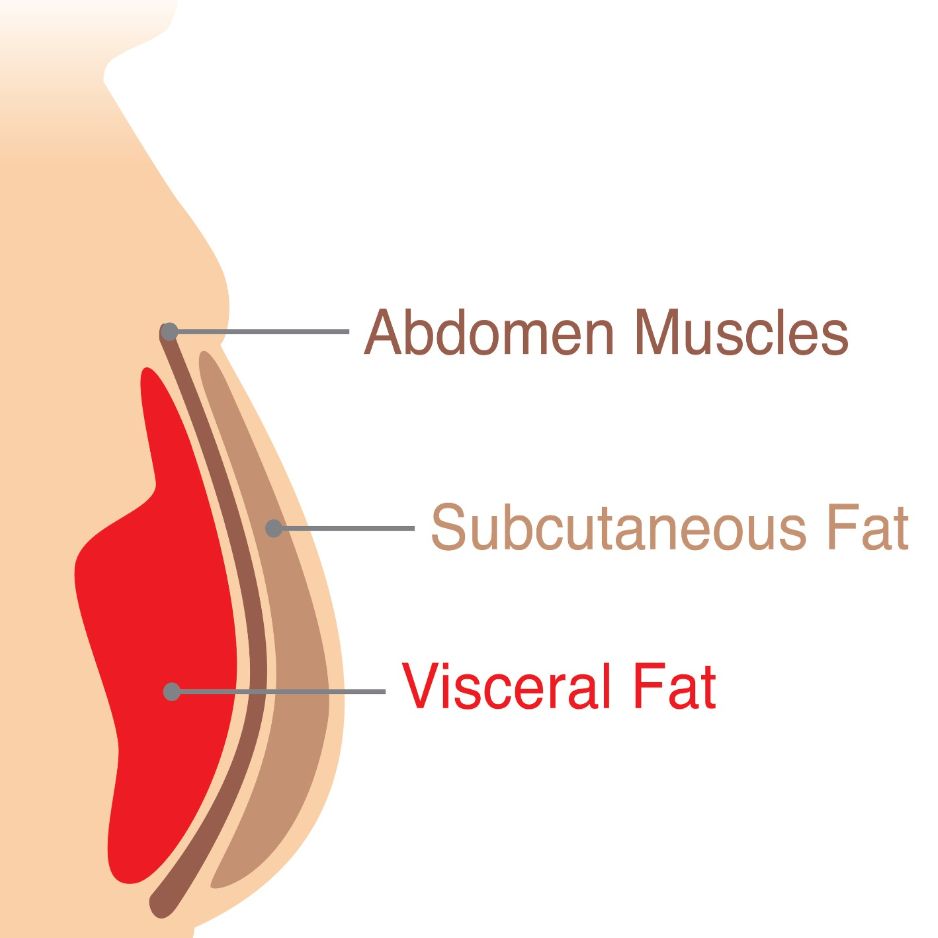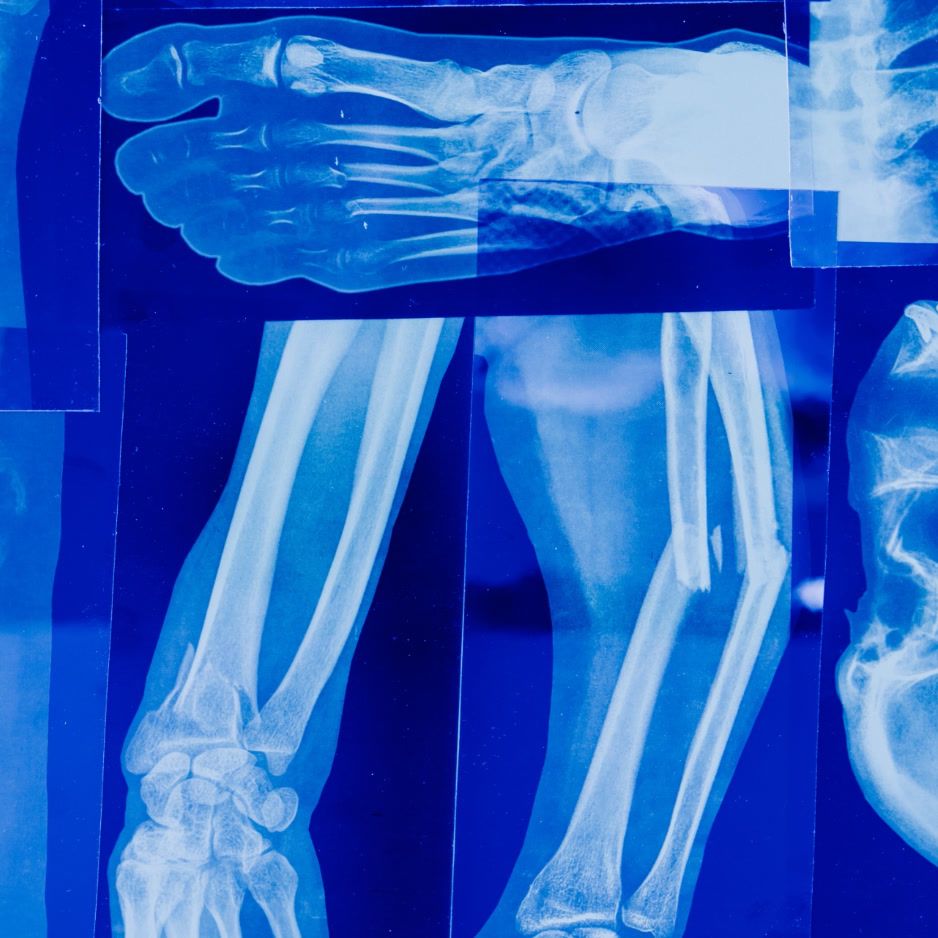Arm Workout Guide for Beginners: 20-Minute Circuit & 4-Week Program

Arm Workout Guide for Beginners: Build Stronger Arms with a 20-Minute At-Home Circuit & 4-Week Gym Program
Arm workouts don’t have to eat up your schedule—or your wallet.
Whether you’re training in a dorm room, squeezing sessions between Zoom calls, or just learning what a “curl” feels like, this guide delivers two plug-and-play options for true beginners:
- a 20-minute, minimal-gear circuit you can do anywhere
- a structured 4-week progression that eases you into gym training for serious size and strength
Along the way, we’ll explain how targeted arm training impacts the body-composition metrics in your BodySpec DEXA scan report and share science-backed exercise selections to keep every rep intentional.
Quick-Start: Minimal Equipment Checklist
Before you worry about fancy machines, start with this pared-down toolkit. It costs less than one month of most gym memberships and works for every exercise in this article.
| Item | Why You Need It | Beginner Tip |
|---|---|---|
| Light & medium resistance loop bands | Provide scalable tension for band hammer curls, pull-aparts, and shoulder warm-ups | Buy a set that lists pound equivalents so you can track progress |
| Sturdy chair or coffee table | Doubles as a dip station and an incline bench | Test stability first—if it wobbles, skip it |
| Backpack or tote bag | Turns household items into adjustable weight | Fill with stable, dense items (e.g., books, water bottles, sandbags). Pack securely to prevent shifting and gradually increase weight as you get stronger. |
| Water bottle (32 oz) | Hydration + makeshift light dumbbell for warm-up curls | Fill completely for a consistent ~2-lb warm-up weight |
| Towel | For iso-holds and improving grip during certain exercises | Roll it tight for better grip |
Good-to-know: You can build real muscle with nothing but bands and a backpack. Research shows that light loads (~30 % 1RM) taken close to failure stimulate muscle growth comparable to heavy weights (systematic review & meta-analysis).
Why Train Arms Separately?
Biceps and triceps account for a relatively small portion of total muscle mass, yet improved definition is consistently one of the top physique goals in DEXA clients. Small muscles fatigue quickly, which means they respond well to short, focused sessions you can tack onto existing workouts or use as stand-alone finishers.
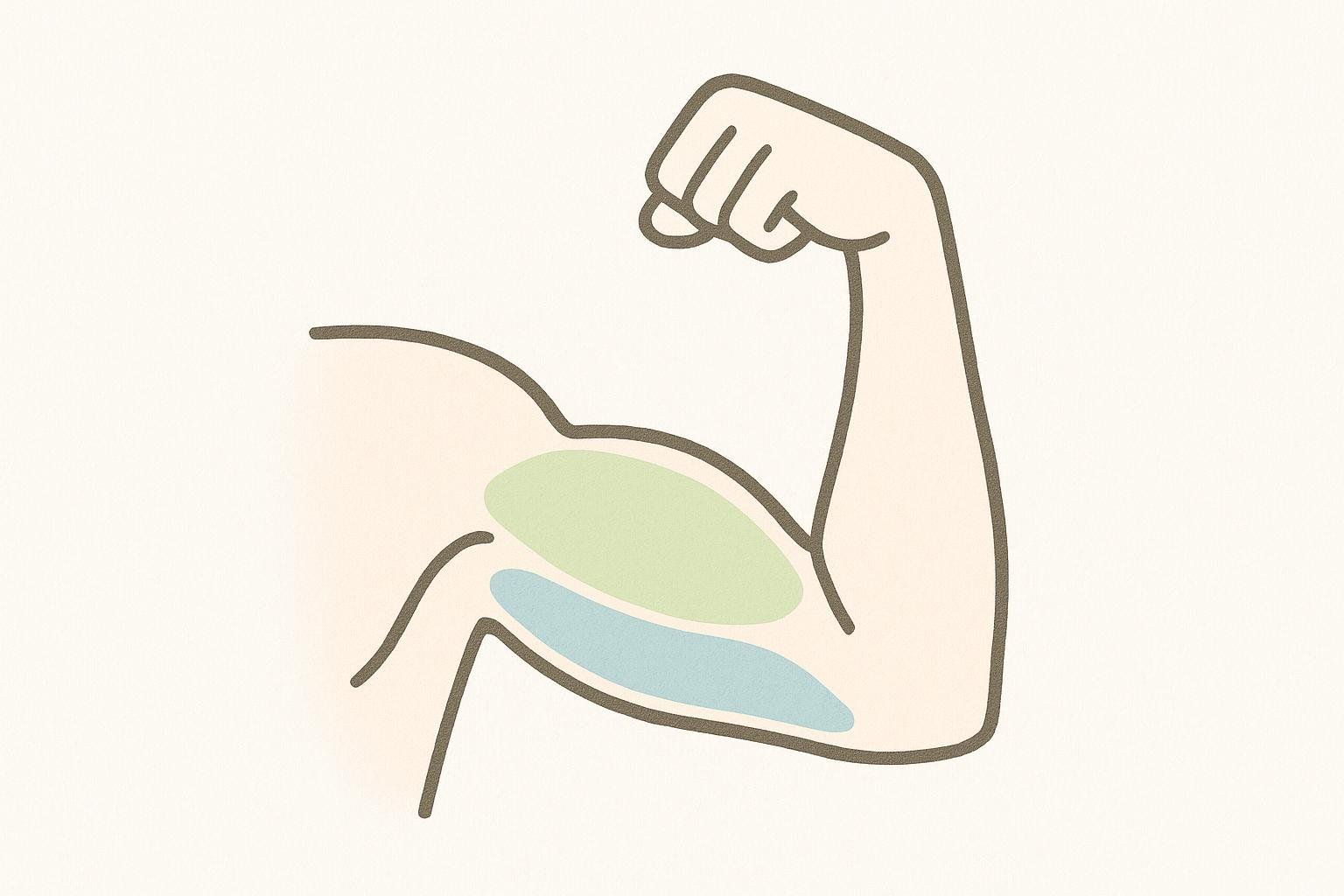
From a health perspective, stronger elbow flexors and extensors also improve grip endurance, posture, and shoulder stability. BodySpec can help you track these improvements by analyzing changes in your limb-specific lean mass.
20-Minute At-Home Arm Circuit (No Bench Required)
This circuit is ideal for building foundational strength and toning your arms while requiring only the items from the checklist above.
| Exercise | Main Muscles | How To | Reps | Rest |
|---|---|---|---|---|
| Chair/Bench Dips | Triceps | Hands on edge, feet extended, shoulders down; keep torso close to bench, lower until elbows are at about a 90-degree angle, then press up | 8–12 | 30 s |
| Backpack Biceps Curl | Biceps | Stand tall, feet hip-width, elbows pinned to sides; supinated curl backpack toward shoulders without swinging | 8–12 | 30 s |
| Incline Push-Up (hands on chair) | Triceps + Chest | Hands shoulder-width on chair, body in straight line; lower chest to edge, elbows tucked ~45°, push back | 8–12 | 30 s |
| Band Hammer Curl | Biceps/Brachioradialis | Loop band under feet, palms neutral; keep wrists straight, curl to shoulders, control descent | 10–15 | 30 s |
| Overhead Backpack Triceps Ext. | Triceps (long head) | Grip backpack overhead, elbows pointing forward; lower behind head until forearms parallel, extend fully | 10–15 | 30 s |
Circuit Directions for Beginners
- Warm up with two minutes of arm circles and wrist mobility.
- Perform each move back-to-back. Rest 90 seconds after all five.
- Repeat for two rounds your first week; build to three rounds as it gets easier.
- Progress weekly by adding 1–2 reps per exercise or increasing backpack weight.
- Aim to complete this circuit 2–3 times per week on non-consecutive days.
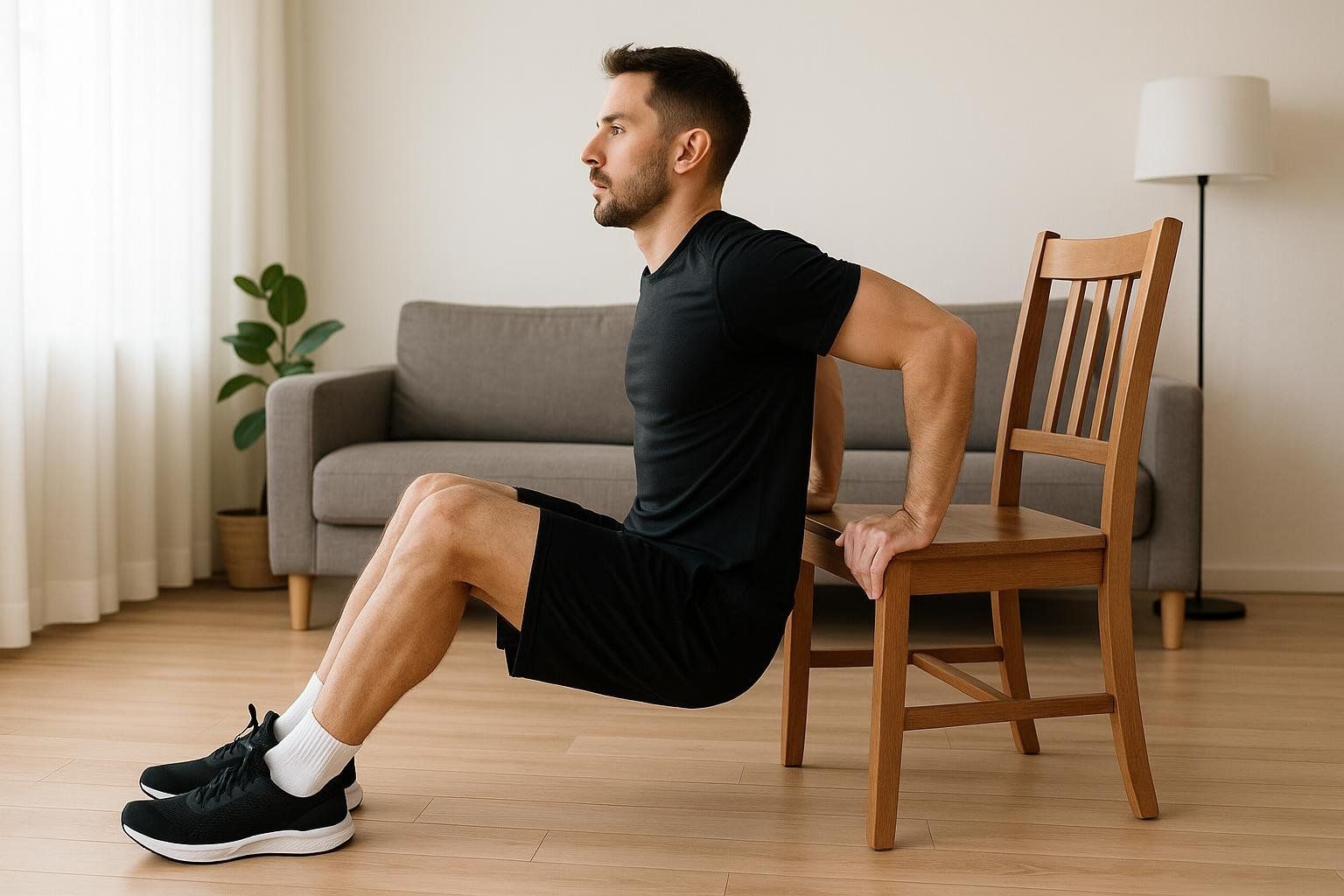
4-Week Progressive Biceps & Triceps Growth Plan
Ready to step into the gym? This beginner-friendly program uses just one barbell, a pair of dumbbells, and a cable stack—equipment you’ll find in even the smallest commercial facilities.
Schedule Options
• Dedicated days: Perform Day A on Tuesday and Day B on Friday.
• Integrated split: Add Day A to an upper-body workout and Day B to another non-consecutive training day (such as a lower-body session), ensuring at least 48 hours between direct arm work.
Understanding Tempo 2-1-1
A tempo notation describes how long each phase of a rep should last. 2-1-1—a 2-second lowering (eccentric), 1-second pause, and 1-second lift (concentric)—is easier for novices to control than slower tempos but still extends time under tension.
Day A – Strength Focus
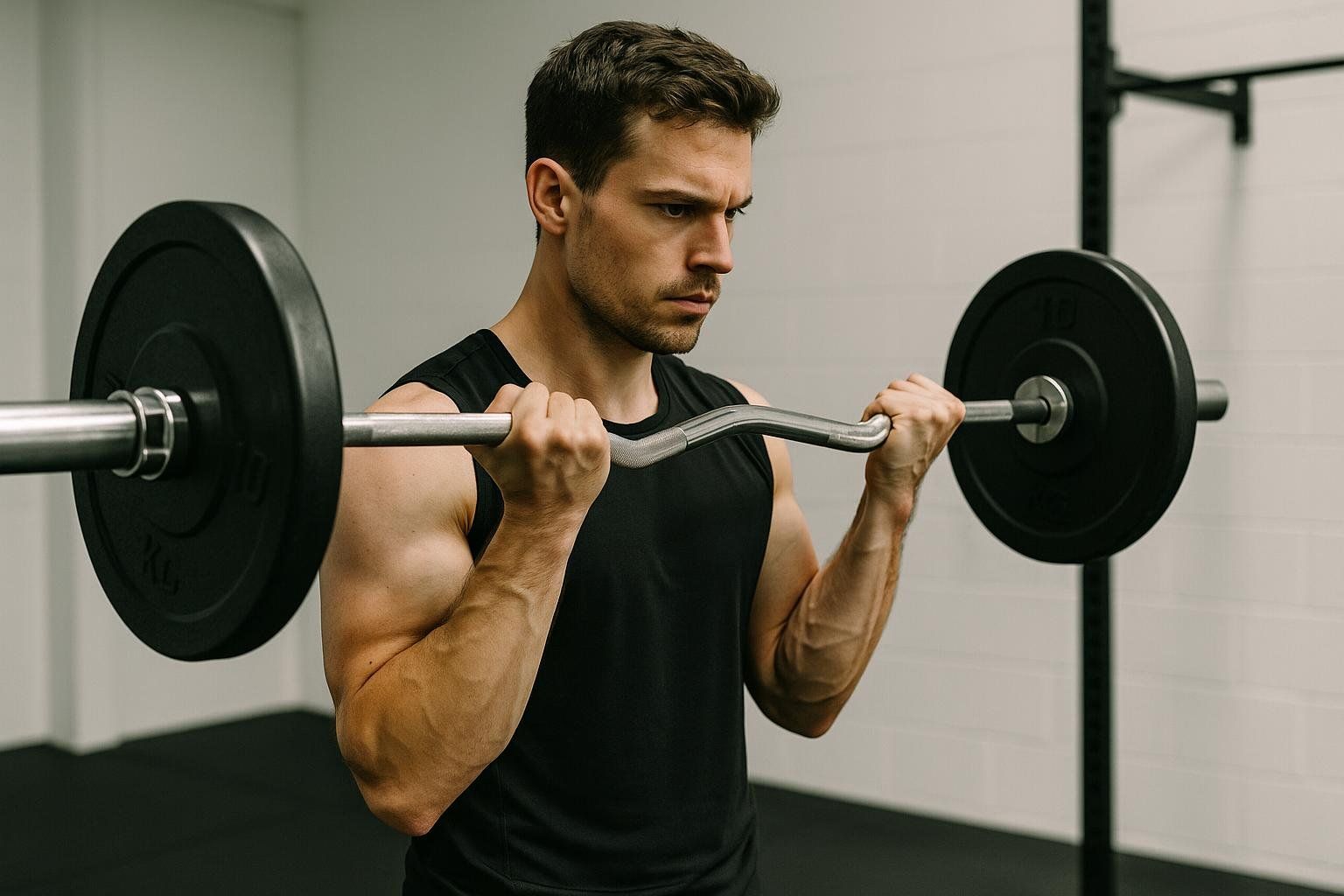
| Week | Barbell Curl | Close-Grip Bench Press | Dumbbell Hammer Curl |
|---|---|---|---|
| 1 | 3 × 8 | 3 × 8 | 3 × 10 |
| 2 | 4 × 8 ↑ | 4 × 8 ↑ | 3 × 10 |
| 3 | 4 × 8 + 2.5–5 lb | 4 × 8 + 2.5–5 lb | 3 × 10 + 2.5–5 lb |
| 4 | 3 × 8 (85 % weight) | 3 × 8 (85 % weight) | 2 × 10 (85 % weight) |
Day B – Pump & Control Focus
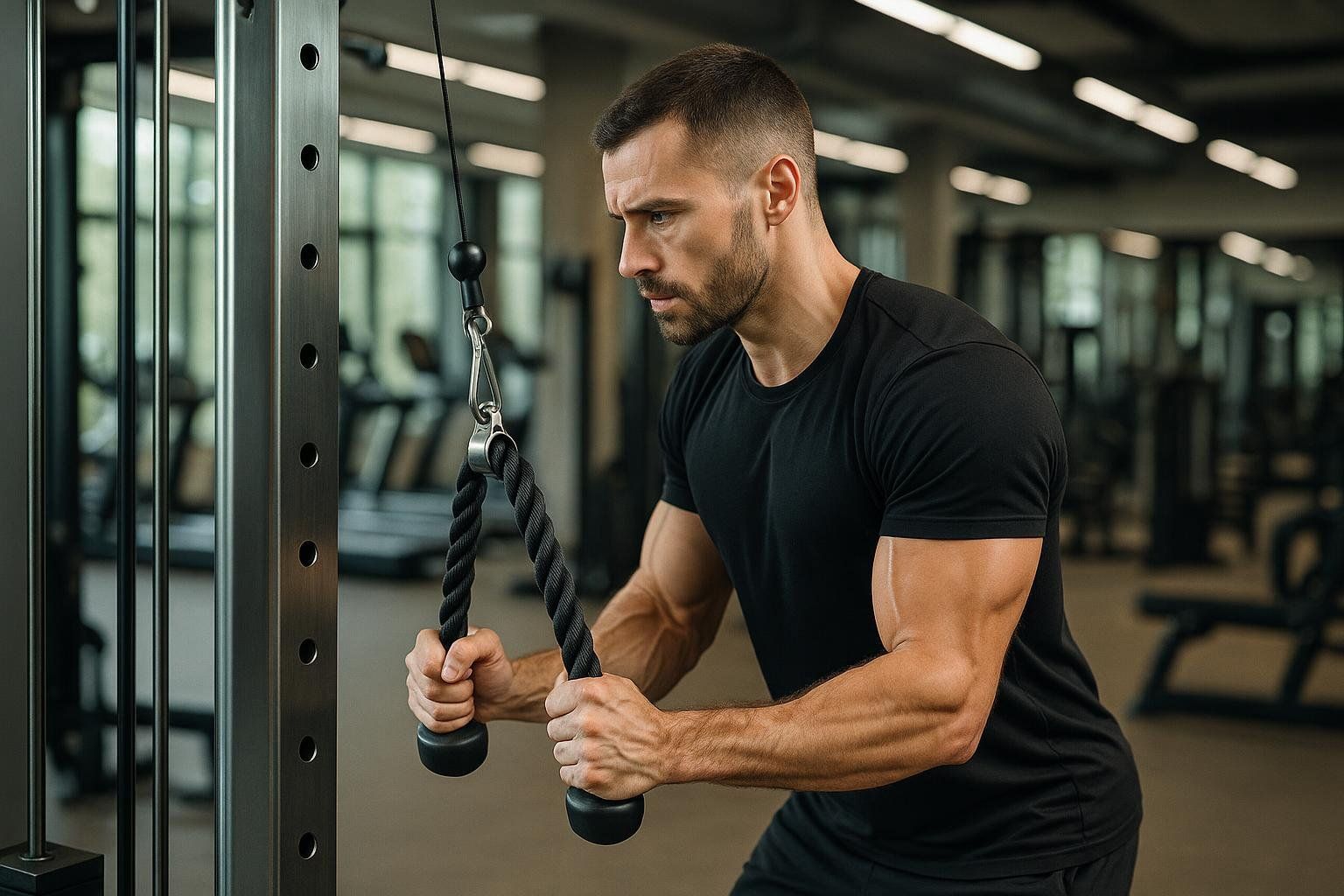
| Week | Cable Triceps Push-Down | Seated Dumbbell Curl | Overhead Cable Extension |
|---|---|---|---|
| 1 | 3 × 12 | 3 × 12 | 3 × 12 |
| 2 | 3 × 13 ↑ | 3 × 13 ↑ | 3 × 13 ↑ |
| 3 | 3 × 13 (tempo 2-1-1) | 3 × 13 (tempo 2-1-1) | 3 × 13 (tempo 2-1-1) |
| 4 | 2 × 13 (85 % weight) | 2 × 13 (85 % weight) | 2 × 13 (85 % weight) |
Arrows (↑) signal a planned progression—extra sets on Day A or extra reps on Day B. Week 3 adds weight (Day A) or tempo control (Day B), and Week 4 is a deload.
Tips for Beginners
- Stand tall, elbows fixed: Imagine pinning your upper arms to your ribcage on curls to avoid swinging.
- Use collars and spotters: Barbell training is safe when you secure plates and ask staff for form checks.
- Log every workout: Record weight, sets, and reps so progress doesn’t stall.
- Track results: Use your next DEXA scan to measure muscle mass and confirm limb-specific gains instead of relying solely on mirror checks.
Office-Friendly “Micro” Arm Moves
When meetings pile up, these unobtrusive exercises fight keyboard posture in under two minutes:

- Towel Iso Biceps Hold – Loop a towel under one foot, curl halfway, and hold 20 s per side. Cue: keep shoulders down, wrist neutral.
- Desk-Edge Triceps Push-Up – Hands on desk, elbows in, 10–12 reps. Cue: maintain plank—core tight, glutes squeezed.
- Band Pull-Apart – Light band, 2 × 15, resets scapular position. Cue: squeeze shoulder blades together, arms stay straight.
Do a single set every 60–90 minutes to accumulate meaningful volume without sweating through your blazer.
Comparing Dumbbells, Bands, and Cables
| Tool | Pros | Cons | Best Uses |
|---|---|---|---|
| Dumbbells | Natural wrist rotation; easy to overload | Need progressively heavier weights | Heavy curls, skull-crushers |
| Resistance Bands | Portable; joint-friendly variable tension | Harder to quantify exact load | Home workouts (band curls, band push-downs), warm-ups, rehab |
| Cables | Constant tension; versatile angles | Gym access required | Beginner staples like triceps push-downs and cable curls—smooth, controlled tension |
Most lifters—especially beginners—benefit from combining modalities to stress the arm musculature through different strength curves.
Nutrition & Supplement Cheatsheet (Made Simple)
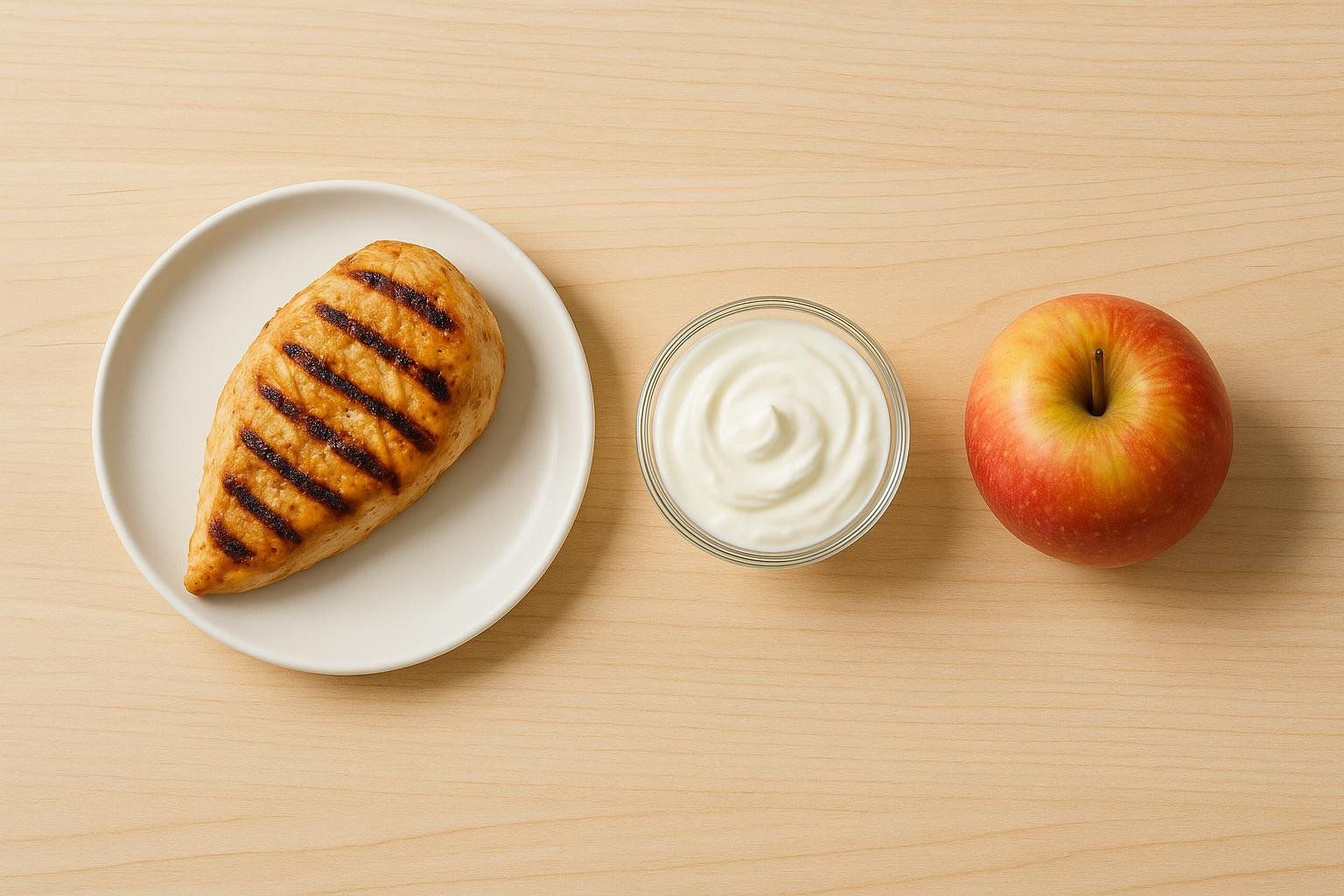
- Protein: Aim for roughly 25 g of protein per meal. This typically corresponds to portions like 4 oz lean chicken, one small can of tuna (check label), or 1 cup of Greek yogurt.
- Creatine Monohydrate: 3–5 g daily can enhance strength and lean-mass gains (ISSN Position Stand).
- Carbs Pre-Workout: A piece of fruit or a slice of toast 60 minutes pre-lift fuels endurance.
- Hydration: Keep that 32-oz water bottle from the checklist and sip through the day—dehydration can impair performance.
- For deeper timing strategies, see When Nutrient Timing Matters.
Measuring Progress Beyond the Tape Measure

Traditional circumference tracking can’t reveal where gains occur. A BodySpec DEXA scan isolates lean mass in each limb, so you’ll see precisely how much muscle you’ve added to your arms—and whether you kept visceral fat in check. Pair scans every 6–8 weeks with photos for the clearest feedback loop.
Arm Workout FAQ
How often should I train arms?
Two to three direct sessions per week are plenty when overall training volume hits 10–15 hard sets for biceps and triceps.
Will push-ups alone build my arms?
Push-ups hammer the triceps but provide limited biceps stimulus. Add curls or rows for balanced growth.
Do I need heavy weights?
Mechanical tension drives hypertrophy, but research shows light loads (~30 % 1RM) taken to failure can elicit similar muscle growth to heavy loads (systematic review & meta-analysis).
Can arm workouts burn fat off my arms?
Spot-reduction myths persist. While building muscle may tighten the area, overall fat loss is systemic. For practical strategies, see our guide to reducing visceral fat.
Ready to Flex? Book Your Scan
Short, focused sessions add up fast. Lock in your baseline with a BodySpec DEXA scan, follow one of the plans above, and compare results in six weeks. Stronger, more defined arms are just a few intentional reps away—see you in the truck!

